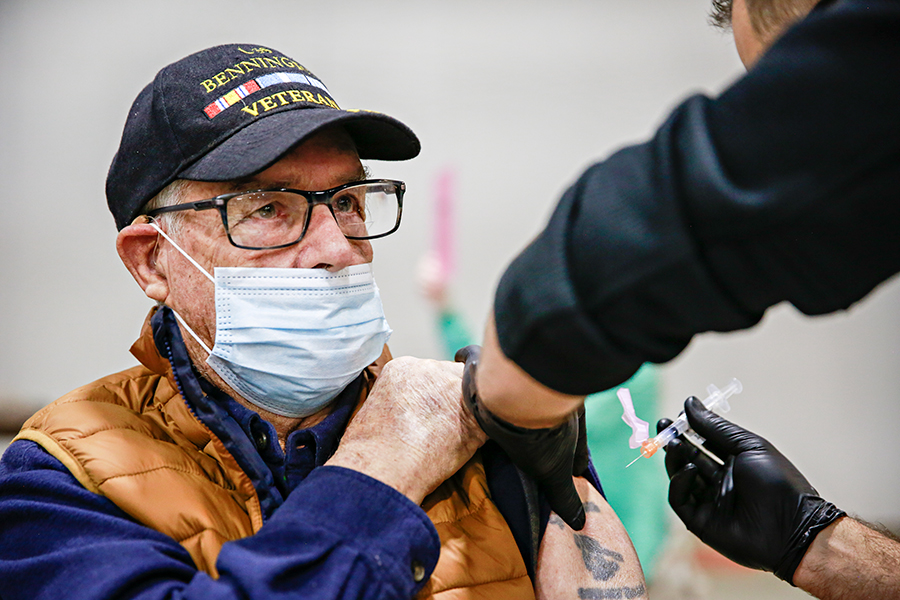Health Officials Remain Committed to Boosting County’s COVID Vaccine Uptake
Large percentage of most vulnerable residents have been immunized as officials turn their attention toward younger ages
By Andy Viano
Flathead County’s most vulnerable have opted for the COVID-19 vaccine at a much higher rate than the rest of the population, but as cases rise among younger people health officials are targeting those age groups and those with questions about the safety of the vaccine in an effort to boost the county’s sluggish overall numbers.
As of May 21, just 31.7% of eligible Flathead County residents were fully immunized against COVID-19 and just 38.2% had received a first dose. Those numbers are well below statewide and national averages, and considerably short of the types of percentages that could offer the community broad protection from the virus.
At the monthly Flathead City-County Board of Health meeting on May 20, Health Officer Joe Russell broke down the county’s vaccine data by age group and revealed that among residents 70 and older, vaccine uptake was excellent, at over 70% for a first dose. Any younger, however, and the percentage drops consistently, with just 21% of residents between 18-29 receiving at least one dose. As Russell went on to note, cases among younger residents are rising while fewer older residents are contracting the virus.
“As expected,” Russell wrote in his monthly report to the board, “there appears to be an inverse relationship between vaccination rates and the prevalence of illness.”
The high rate of vaccination among older people has also, as expected, kept the number of residents hospitalized at any one time to a manageable level. Serious illnesses are up slightly in May compared to earlier in the spring — as are overall cases — but hit a modest spike of nine hospitalizations on May 10. During the height of the pandemic, 39 people were hospitalized in the county on Nov. 30.
The Flathead City-County Health Department (FCCHD) is continuing to hold vaccine clinics at the Flathead County Fairgrounds, with appointments available by scheduling online at flatheadhealth.org/covid-19-vaccine or on a walk-in basis. Vaccine appointments can also be made at a number of participating local pharmacies via vaccinefinder.org. All residents 12 and older are currently eligible to receive the vaccine.
Logan Health (formerly Kalispell Regional Healthcare) has also unveiled a mobile vaccine unit that they plan to use throughout Northwest Montana this spring and summer, and county health officials say they would like to offer some satellite clinics as well, including in more remote areas, to service residents who may have trouble getting to a clinic in Kalispell during regular business houses. Officials are also considering an incentive program to target younger populations.
But health experts agree that the best chance they have to convince someone to get immunized is by delivering facts about COVID-19 and the vaccines through a trusted source like a family doctor.
“We’ve actually identified that as the main thing we need to be doing,” Russell told the Beacon in an interview earlier this month. “I really do believe the message is a lot stronger coming from a medical care provider.”
Dr. Peter Heyboer, an internist who serves on the board or health and chairs its COVID-19 committee, said he has had a number of conversations with his patients about the vaccine. In doing so, he’s generally seen three classes of people in his practice: those who were eager to get the vaccine and have already done so, those who were dead-set against it and cannot be convinced, and those who are on the fence.
“There’s a sizeable group that have questions, have heard some things misreported, or (heard) misinformation, and they just have questions,” Heyboer said. “And those people, I think, are very potentially reachable if they’re willing to engage in a conversation.”
One of the missing pieces, however, is that vaccines are not available at most doctors’ offices in Flathead County, including Heyboer’s. That could change in the coming weeks and if it does it will allow those trusted doctors to deliver the shot personally.
“The more we can get vaccines into the primary care doctors’ offices to have those discussions and immediately give it after you’ve had the discussion, allayed their fears, answered their questions, the better,” Heyboer said.
The range of questions people have had for Heyboer has been wide, including some who he says have asked about 5G signals and microchips, but the bulk of the questions have surrounded the Food and Drug Administration’s (FDA) Emergency Use Authorizations for the vaccines, the first of which was issued in December, less than a year after scientists began researching the virus in earnest. The emergency authorization is a process that the FDA can utilize “when certain criteria are met, which includes that there are no adequate, approved or available alternatives” in order to expedite the rollout of a drug. It is a less rigorous process than is necessary for the full approval and conspiracy theorists have tried to dissuade people from getting vaccinated because the FDA never “approved” the vaccines, a mostly semantic argument that may contribute to some people’s vaccine hesitancy. One vaccine maker, Pfizer, has recently requested full FDA approval for its vaccine.
Heyboer said that to counter the idea of a rushed approval process, he explains what the emergency authorization means and how drug makers were able to conduct large trials so quickly. Simply put, he said, pharmaceutical companies typically move slowly through drug trials, starting with step “A and then B and then C and then D” in part because of how costly the process can be. In the case of the COVID-19 vaccine, a wave of government funding available for research allowed companies to perform steps A, B, C and D at the same time.
“All of the same safety steps are taken. It’s going through all the steps but they’re doing them simultaneously,” he said. “They’re not shortcuts. Steps aren’t skipped.”